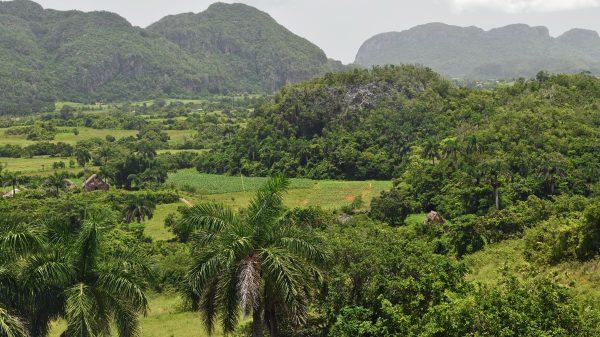An important U.S. – Cuba business conference, critical to opening markets for American farmers, took place in and around Havana, Cuba recently. Representatives from both countries participated.
Now that U.S. exporters are allowed to use USDA programs to promote exports to Cuba, the U.S. Agriculture Coalition for Cuba (USACC) and FocusCuba sponsored the event in an effort to assist American farmers in understanding all aspects of the demand for food in Cuba and also how to best to learn how to use FMA/MAP grant funds. Americans attending the event represented many others from Illinois, Kansas, Arkansas, Texas, Washington DC, New Jersey
The American group visited a series of markets where they learned how Cuban citizens purchase food through state rationing and a heavily subsidized distribution system. They also met with a Cuban farm Cooperative. They elect their own leadership and vote as a democracy on important decisions affecting them collectively. Farm Coops work with ACOPIO, a state agency of the Cuban government that purchases the agricultural products produced by the farmers for a fixed and guaranteed price. However, the group learned that food production in Cuba has declined this year, mostly because of a lack of seed and necessary agricultural equipment. Other problems also affect the ultimate availability of crops such as post-harvest losses resulting from a lack of quality storage facilities and spoilage.
During a visit with Alimport officials, the Cuban governmental agency responsible for food imports from the U.S., the group learned that 2019 imports from the U.S. will be about the same as that of 2018—about $220 million. However, the projections for 2020 are expected to be lower. The reasoning appears to be framed around concerns about the current political environment and tension between the two countries. Amid these concerns, Alimport continued to express great interest in purchasing more food from U.S. farmers. Reasons for such interest centers on three critical points:
- Quality of food from U.S. farmers is better than most other sources;
- Speed of delivery, ensuring no shrinkage caused by delays (U.S. products can arrive in Cuba in 10-14 days, while food from Vietnam and China take a minimum of 40-50 days, often arriving inedible because of spoilage.);
- Because of proximity to Cuba, shipping costs are dramatically less from the U.S. as opposed to that from Asia, thus lowering the expense to the Cubans.
Presentations were made by several Cuban officials and other executives responsible for importing and even setting agriculture policy. The group learned the current hardships on paying cash in-advance for the soy and chicken currently being purchase from U.S. sources. Because U.S. law requires to be paid in U.S. dollars and buy xanax in Cuba such doesn’t exist in Cuba, the Cubans must send Euros to Europe to have the money converted to U.S. dollars and then forwarded back to the U.S. Money exchanging of this sort is not only cumbersome, it is expensive, ultimately costing the Cubans to pay more money for the food. Allowing U.S. farmers to sell to the Cubans on credit and then allow standard bank transfers would alleviate this costly exercise.
One of the organizers of the conference is Paul Johnson, chair of the USACC, an organization that supports improved agriculture trade relations with the island.
“American farmers and ranchers will tell you that they need more markets for their products. Well, Cuba represents one such market. We are here in Cuba this week to underscore that message and bring awareness to members of the U.S. Congress as to what is available for the American AG industry.”
About Cuban Agriculture
It is estimated that around 70% of agriculture products grown on rural farms in Cuba are organic and completely free of all chemicals. They currently produce enough rice to fulfill about 50% of Cuba’s rice demands. They also produce 90% of the tropical fruit consumed in Cuba, including avocados and papaya. They could actually produce an even larger amount of these products and export to the U.S. if there was a market. Under normalized trade relations, Cuba could export these products to the U.S., allowing them to purchase more goods from U.S. farmers and ranchers including rice, soybeans, corn and wheat.
Another unique product of Cuba is the Habano, the name for Cuban cigars, known
About Cuban Cooperatives
In very recent years, many new Cuban governmental reforms have affected the country’s agriculture industry. Those who choose to farm in Cuba are offered 26.84 hectares (67 acres) of land on a lease basis. If they add livestock production, they will be given an additional 26.80 hectares (for a total of 134 acres). Further, the government provides the farmers, seed, fertilizer, tools
For nearly 30 years, U.S. Citizen Gary Heathcott has been traveling to his home-away-from-home: CUBA. A retired advertising and public relations executive, Heathcott has been pushing to improve communications and relations between his birth-country and his adopted-country of Cuba.
Heathcott is the Director of Cuba Films and Cuba Medios and is accredited to the International Press Centers in Havana and Washington D.C. For the past three years, Heathcott has served as the auctioneer at the prestigious Gala Dinner on the final evening of the Habano Festival in Havana, Cuba. In 2016, his first auction effort in Cuba, Heathcott raised a record amount of money for the Cuban Public Health System: €1.3 million. In 2017, he surpassed that amount by raising another €1.7 million. At this past February’s Gala, Heathcott sold 7 more humidors for €1.5 million bringing the total raised for the public health and research to €4.5 million!
Internationally-known, his writings and documentary films about the country of Cuba, her people and Cuba’s trademark export—hand-rolled cigars—have been published in magazines and on networks around the world. He has also been interviewed many times by other journalists from China, France, Canada, Japan, Spain, Germany, and others: from U. S. television networks to the New York Times and dozens of other American newspapers. He most recently contributed to Associated Press and Reuters news accounts regarding the U.S.’s potential lifting of the decades-old embargo.
Twenty-three years ago, Heathcott championed the effort of legally presenting a container of American-produced rice to the Catholic Relief Organization in Cuba, paving the way for U.S. to ease its restrictions with regard to selling food to the Cuban government. The container of Riceland Rice from Arkansas was not only delivered to Havana, but Heathcott orchestrated U.S. news coverage of the event through an exclusive arrangement with ABC News correspondents.
In May 2016, Heathcott was invited to the U.S. White House and participated in a dialogue with OFAC, U.S. Treasury Department and Obama Administration officials, as they discussed various ways to advance American business opportunities between Cuba and the United States.
Heathcott’s Cuban documentary films have been distributed world-wide and include such films as “The Passion of the Torcedor”, “Footprints in the Sand: Hemingway’s Cuba”, “El Ritual de Los Cohiba”, “Cuba’s Daiquiri—the Original”, and “The Future of Cuba: Her Youth”. He has written more than 60 feature articles regularly appearing in major magazines in the U.S., Europe, and on-line, including SMOKE Magazine, American Cigar, SmokeShop Magazine, Tobacco International, and many more.
Heathcott has hoped for decades that the U.S. government would eliminate the world’s longest-lasting economic embargo. All the while, Heathcott has been relentless in his support of the Cuban people, consistently bringing American doctors and nurses to the island, along with wheelchairs, medical equipment, surgical devices, eyeglasses, all types of medicines and vitamins, computers, cameras, telephones, shoes for hospital workers, and even automobile parts for the aging American cars. (The most unique item brought to Cuba by Heathcott? A front bumper for a 1956 Chevrolet for the brother of a cigar factory employee. The most expensive item? A $34,000 pediatric video gastroscope to fit an Olympus Endoscopy System in a children’s diagnostic hospital.) And this was all done completely within existing regulations of the two countries involved.
In his journalistic responsibilities, Heathcott has attended all 21 of Cuba’s Habanos Festivals, the world’s most prestigious gathering to celebrate the Cuban Cigar. He has not only written news accounts of each week-long event, he has also participated in the Festivals in numerous ways, including serving as a judge for the very popular International HabanoSommelier Competition, where finalist from various countries around the world pair Cuban cigars with alcohol spirits.
At the 2015 Habanos Festival, Heathcott was selected as the Habanos Man of the Year for Communications. At the 2013 Habanos Festival, Heathcott was honored for one of his recent documentary films. “El Ritual de Los Cohiba”, chronicling the 40-year history of Cohiba cigars. It was the first-ever film detailing the complete story of how Fidel Castro desired to create a hand-rolled cigar for the masses while also establishing a secondary workforce by employing women exclusively for the production of the all-new cigar. From the quiet birth of the original lancero to its famed voyage into outerspace to the grandest habano ever created—the Behike, the film was digitally recorded completely in Cuba and was presented in its native-tongue Spanish and subtitled in English.














